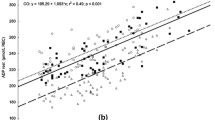Summary
Previously sedentary men (n=23) and women (n =18) were trained to run a half marathon contest after 40 weeks. Total blood glutathione had increased by 20 weeks of training and had returned to normal after 40 weeks. Erythrocyte glutathione reductase activity had increased by 20 weeks and remained elevated after 40 weeks. This effect was accompanied by decreases in glutathione reductase coefficients, which indicated that increases in the presence of riboflavin may have been responsible for the changes in reductase activity. Erythrocyte glutathione S-transferase activity had increased slightly after 20 weeks of training and a much more marked increase was found after 40 weeks. This may have been indicative of the occurrence of lipid peroxidation in this phase of training. The participants ran a 15-km race after the first 20 weeks of training and a half marathon after 40 weeks. Blood glutathione tended to decrease after the 15-km race and increased after the half marathon. In both cases it had returned to normal values 5 days after the race. Erythrocyte glutathione reductase was elevated 1 day after the races, and had returned to normal after 5 days. This could also have been explained from concurrent changes in the riboflavin content of the erythrocytes. Erythrocyte glutathione S-transferase activity decreased after both races, but was restored 5 days after the half marathon while such was not the case after the 15-km race.
Similar content being viewed by others

References
Anderson ME (1985) Determination of glutathione and glutathione disulfide in biological samples. Meth Enzymol 113:548–555
Banister EW, Rajendra W, Mutch BJC (1985) Ammonia as an indicator of exercise stress — implications of recent findings to sports medicine. Sports Med 2:34–46
Brouwer EJ, Evelo CTA, Verplanke AJW, Welie RTH van, Wolf FA de (1991) Biological effect monitoring of exposure to 1,3dichloropropene: effects on liver and renal function and on glutathione conjugation. Br J Ind Med 48:167–172
Carlberg I, Mannervik B (1985) Glutathione reductase. Meth Enzymol 113:484–490
Duthie GG, Robertson JD, Maugham RJ, Morrice PC (1990) Blood antioxidant status and erythrocyte lipid peroxydation following distance running. Arch Biochem Biophys 282:78–80
Freeman ML, Spitz DR, Meredith MJ (1990) Does heat shock enhance oxidative stress? Studies with ferrous and ferric iron. Radiat Res 124:288–293
Habig WH, Jakoby WB (1981) Assays for the differentiation of glutathione S-transferases. Meth Enzymol 77:398–405
Janssen GME, ten Hoor F (1989) Marathon running: functional changes in male and female subjects during training and contests. Int J Sports Med [Suppl 3] 10:117–190
Jenkins RR (1988) Free radical chemistry. Relationship to exercise. Sports Med 5:156–170
Ji LL, Stratman FW, Lardy HA (1988) Antioxidant enzyme systems in rat liver and skeletal muscle. Influences of selenium deficiency, chronic training and acute exercise. Arch Biochem Biophys 263:150–160
Kaiser V, Janssen GME, Wersch JWJ van (1989) Effect of training on red blood cell parameters an plasma ferritin: a transverse and a longitudinal approach. Int J Sports Med 10 [Suppl 3]:169–175
Kampen EJ van, Zijlstra WG (1965) Determination of hemoglobin and its derivatives. Adv Clin Chem 8:141–187
Mannervik B, Danielson UH (1988) Glutathione Transferases — structure and catalytic activity. Crit Rev Biochem 23:283–337
Maugham RJ, Donnelly AE, Gleeson M, Whiting PH, Walker KA, Clough PJ (1989) Delayed onset muscle damage and lipid peroxidation in man after a downhill run. Muscle Nerve 12:332–336
Nilsson S, Marklund L (1988) Effect of venous stasis and physical exercise on plasma extracellular-superoxide dismutase. Scand J Clin Lab Invest 48:441–444
Ohno H, Yahata T, Sato Y, Yamamura K, Taniguchi N (1988) Physical training and fasting erythrocyte activities of free radical scavenging enzyme systems in sedentary men. Eur J Appl Physiol 57:173–176
Pincemail J, Deby C, Camus G, Pirnay F, Bouchez R, Massaux L, Goutier R (1988) Tocopherol mobilization during intensive exercise. Eur J Appl Physiol 57:189–191
Tietz NW (ed) (1986) Textbook of clinical chemistry. Saunders, Philadelphia, pp 946–949
Author information
Authors and Affiliations
Rights and permissions
About this article
Cite this article
Evelo, C.T.A., Palmen, N.G.M., Artur, Y. et al. Changes in blood glutathione concentrations, and in erythrocyte glutathione reductase and glutathione S-transferase activity after running training and after participation in contests. Europ. J. Appl. Physiol. 64, 354–358 (1992). https://doi.org/10.1007/BF00636224
Accepted:
Issue Date:
DOI: https://doi.org/10.1007/BF00636224


